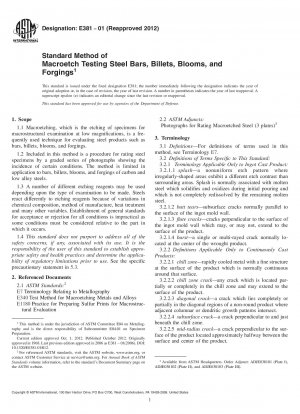ASTM E381-01(2012)
Standard Method of Macroetch Testing Steel Bars, Billets, Blooms, and Forgings
- Standard No.
- ASTM E381-01(2012)
- Release Date
- 2001
- Published By
- American Society for Testing and Materials (ASTM)
- Status
- Replace By
- ASTM E381-17
- Latest
- ASTM E381-22
- Scope
- 4. Significance and Use
4.1 Macroetching is used in the steel industry because it is a simple test that will provide information about the relative homogeneity of the sample. The method employs the action of an acid or other corrosive agent to develop the macrostructural characteristics of a suitably prepared specimen. The name implies that the etched surface is examined visually, or at low magnifications (usually lt;10??).
4.2 Macroetching will show: (1) variations in structure such as grain size, dendrites, and columnar structure; (2) variations in chemical composition such as segregation, coring, and banding; and, (3) the presence of discontinuities such as laps, seams, cracks, porosity, bursts, pipe. and flakes.
4.3 When, in accordance with the requirements of the inquiry, contract, order or specifications, forgings, billets, blooms, etc., are to be produced subject to macroetch testing and inspection, the manufacturer and the purchaser should be in agreement concerning the following: (1) the stage of manufacture at which the test shall be conducted; (2) the number and locations of the sections to be examined; (3) the necessary surface preparation prior to etching of the specimen; (4) the etching reagent, temperature, and time of etching; and, (5) the type, size, number, location, and orientation of conditions that are to be considered injurious.
4.4 When not specified, the procedures of the test may be selected by the manufacturer to satisfy the requirements of the governing specification.
4.5 When agreed upon by purchaser and producer, sulfur printing of as cast-sections, if continuously cast, is an acceptable alternative to macroetching. Sulfur printing shall be performed in accordance with Practice E1180. Examination and rating of specimens shall be in accordance with Sections 10 and 11 of this (E381) standard.
4.6 Steel from ingots shall be examined according to procedures described in Section 9. Continuously cast steel blooms and billets, in the as cast condition, shall be examined according to the procedures described in Sections 10 and 11. With reductions over a 3:1 area ratio, wrought product from continuously cast steel may be examined according to Section
ASTM E381-01(2012) Referenced Document
- ASTM E1180 Standard Practice for Preparing Sulfur Prints for Macrostructural Examination
- ASTM E340 Standard Practice for Macroetching Metals and Alloys
- ASTM E7 Standard Terminology Relating to Metallography
ASTM E381-01(2012) history
- 2022 ASTM E381-22 Standard Method of Macroetch Testing Steel Bars, Billets, Blooms, and Forgings
- 2020 ASTM E381-20 Standard Method of Macroetch Testing Steel Bars, Billets, Blooms, and Forgings
- 2017 ASTM E381-17 Standard Method of Macroetch Testing Steel Bars, Billets, Blooms, and Forgings
- 2001 ASTM E381-01(2012) Standard Method of Macroetch Testing Steel Bars, Billets, Blooms, and Forgings
- 2001 ASTM E381-01(2006) Standard Method of Macroetch Testing Steel Bars, Billets, Blooms, and Forgings
- 2001 ASTM E381-01 Standard Method of Macroetch Testing Steel Bars, Billets, Blooms, and Forgings
- 1998 ASTM E381-98 Standard Method of Macroetch Testing Steel Bars, Billets, Blooms, and Forgings

Copyright ©2024 All Rights Reserved

